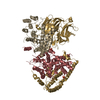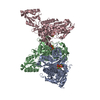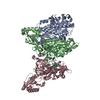[English] 日本語
 Yorodumi
Yorodumi- PDB-5o7x: CRYSTAL STRUCTURE OF S. CEREVISIAE CORE FACTOR AT 3.2A RESOLUTION -
+ Open data
Open data
- Basic information
Basic information
| Entry | Database: PDB / ID: 5o7x | |||||||||
|---|---|---|---|---|---|---|---|---|---|---|
| Title | CRYSTAL STRUCTURE OF S. CEREVISIAE CORE FACTOR AT 3.2A RESOLUTION | |||||||||
 Components Components |
| |||||||||
 Keywords Keywords | TRANSCRIPTION / RNA POLYMERASE I INITIATION / CORE FACTOR | |||||||||
| Function / homology |  Function and homology information Function and homology informationRNA polymerase I transcription regulatory region sequence-specific DNA binding / RNA polymerase I core factor complex / RNA polymerase I general transcription initiation factor activity / RNA polymerase I general transcription initiation factor binding / RNA polymerase I core promoter sequence-specific DNA binding / RNA Polymerase I Promoter Escape / transcription initiation at RNA polymerase I promoter / nucleolar large rRNA transcription by RNA polymerase I / TBP-class protein binding / nucleolus ...RNA polymerase I transcription regulatory region sequence-specific DNA binding / RNA polymerase I core factor complex / RNA polymerase I general transcription initiation factor activity / RNA polymerase I general transcription initiation factor binding / RNA polymerase I core promoter sequence-specific DNA binding / RNA Polymerase I Promoter Escape / transcription initiation at RNA polymerase I promoter / nucleolar large rRNA transcription by RNA polymerase I / TBP-class protein binding / nucleolus / zinc ion binding / nucleus / cytoplasm Similarity search - Function | |||||||||
| Biological species |  | |||||||||
| Method |  X-RAY DIFFRACTION / X-RAY DIFFRACTION /  SYNCHROTRON / SYNCHROTRON /  SAD / Resolution: 3.2 Å SAD / Resolution: 3.2 Å | |||||||||
 Authors Authors | Engel, C. / Gubbey, T. / Neyer, S. / Sainsbury, S. / Oberthuer, C. / Baejen, C. / Bernecky, C. / Cramer, P. | |||||||||
 Citation Citation |  Journal: Cell / Year: 2017 Journal: Cell / Year: 2017Title: Structural Basis of RNA Polymerase I Transcription Initiation. Authors: Christoph Engel / Tobias Gubbey / Simon Neyer / Sarah Sainsbury / Christiane Oberthuer / Carlo Baejen / Carrie Bernecky / Patrick Cramer /  Abstract: Transcription initiation at the ribosomal RNA promoter requires RNA polymerase (Pol) I and the initiation factors Rrn3 and core factor (CF). Here, we combine X-ray crystallography and cryo-electron ...Transcription initiation at the ribosomal RNA promoter requires RNA polymerase (Pol) I and the initiation factors Rrn3 and core factor (CF). Here, we combine X-ray crystallography and cryo-electron microscopy (cryo-EM) to obtain a molecular model for basal Pol I initiation. The three-subunit CF binds upstream promoter DNA, docks to the Pol I-Rrn3 complex, and loads DNA into the expanded active center cleft of the polymerase. DNA unwinding between the Pol I protrusion and clamp domains enables cleft contraction, resulting in an active Pol I conformation and RNA synthesis. Comparison with the Pol II system suggests that promoter specificity relies on a distinct "bendability" and "meltability" of the promoter sequence that enables contacts between initiation factors, DNA, and polymerase. | |||||||||
| History |
|
- Structure visualization
Structure visualization
| Structure viewer | Molecule:  Molmil Molmil Jmol/JSmol Jmol/JSmol |
|---|
- Downloads & links
Downloads & links
- Download
Download
| PDBx/mmCIF format |  5o7x.cif.gz 5o7x.cif.gz | 3.2 MB | Display |  PDBx/mmCIF format PDBx/mmCIF format |
|---|---|---|---|---|
| PDB format |  pdb5o7x.ent.gz pdb5o7x.ent.gz | 2.7 MB | Display |  PDB format PDB format |
| PDBx/mmJSON format |  5o7x.json.gz 5o7x.json.gz | Tree view |  PDBx/mmJSON format PDBx/mmJSON format | |
| Others |  Other downloads Other downloads |
-Validation report
| Summary document |  5o7x_validation.pdf.gz 5o7x_validation.pdf.gz | 743.5 KB | Display |  wwPDB validaton report wwPDB validaton report |
|---|---|---|---|---|
| Full document |  5o7x_full_validation.pdf.gz 5o7x_full_validation.pdf.gz | 1.1 MB | Display | |
| Data in XML |  5o7x_validation.xml.gz 5o7x_validation.xml.gz | 291.3 KB | Display | |
| Data in CIF |  5o7x_validation.cif.gz 5o7x_validation.cif.gz | 383.8 KB | Display | |
| Arichive directory |  https://data.pdbj.org/pub/pdb/validation_reports/o7/5o7x https://data.pdbj.org/pub/pdb/validation_reports/o7/5o7x ftp://data.pdbj.org/pub/pdb/validation_reports/o7/5o7x ftp://data.pdbj.org/pub/pdb/validation_reports/o7/5o7x | HTTPS FTP |
-Related structure data
| Related structure data |  3590C  3591C  3592C  3593C  3594C  5n5yC  5n5zC  5n60C  5n61C C: citing same article ( |
|---|---|
| Similar structure data |
- Links
Links
- Assembly
Assembly
| Deposited unit | 
| ||||||||||||||||||||||||||||||||||||||||||||||||||||||||||||||||||||||||||||||||||||||||||||||||||||||||||||||||||||||||||||||||||||||||||||||||||||||||||
|---|---|---|---|---|---|---|---|---|---|---|---|---|---|---|---|---|---|---|---|---|---|---|---|---|---|---|---|---|---|---|---|---|---|---|---|---|---|---|---|---|---|---|---|---|---|---|---|---|---|---|---|---|---|---|---|---|---|---|---|---|---|---|---|---|---|---|---|---|---|---|---|---|---|---|---|---|---|---|---|---|---|---|---|---|---|---|---|---|---|---|---|---|---|---|---|---|---|---|---|---|---|---|---|---|---|---|---|---|---|---|---|---|---|---|---|---|---|---|---|---|---|---|---|---|---|---|---|---|---|---|---|---|---|---|---|---|---|---|---|---|---|---|---|---|---|---|---|---|---|---|---|---|---|---|---|
| 1 | 
| ||||||||||||||||||||||||||||||||||||||||||||||||||||||||||||||||||||||||||||||||||||||||||||||||||||||||||||||||||||||||||||||||||||||||||||||||||||||||||
| 2 | 
| ||||||||||||||||||||||||||||||||||||||||||||||||||||||||||||||||||||||||||||||||||||||||||||||||||||||||||||||||||||||||||||||||||||||||||||||||||||||||||
| 3 | 
| ||||||||||||||||||||||||||||||||||||||||||||||||||||||||||||||||||||||||||||||||||||||||||||||||||||||||||||||||||||||||||||||||||||||||||||||||||||||||||
| 4 | 
| ||||||||||||||||||||||||||||||||||||||||||||||||||||||||||||||||||||||||||||||||||||||||||||||||||||||||||||||||||||||||||||||||||||||||||||||||||||||||||
| 5 | 
| ||||||||||||||||||||||||||||||||||||||||||||||||||||||||||||||||||||||||||||||||||||||||||||||||||||||||||||||||||||||||||||||||||||||||||||||||||||||||||
| 6 | 
| ||||||||||||||||||||||||||||||||||||||||||||||||||||||||||||||||||||||||||||||||||||||||||||||||||||||||||||||||||||||||||||||||||||||||||||||||||||||||||
| Unit cell |
| ||||||||||||||||||||||||||||||||||||||||||||||||||||||||||||||||||||||||||||||||||||||||||||||||||||||||||||||||||||||||||||||||||||||||||||||||||||||||||
| Noncrystallographic symmetry (NCS) | NCS domain:
NCS domain segments:
|
 Movie
Movie Controller
Controller












 PDBj
PDBj

